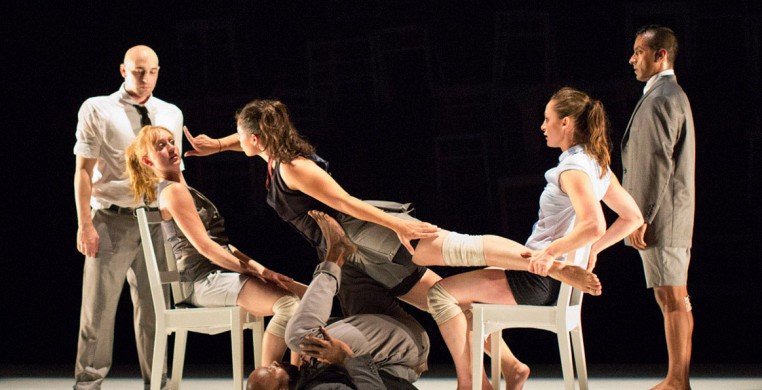One of the best things about The Seldoms’ “Power Goes” (Museum of Contemporary Art, March 20-29) is that its intelligence is so thoroughly organic, not an easy thing to carry off when you’re dancing about Lyndon Baines Johnson! But dance they do, with bold, decisive strokes that form a perfect physical anchor for their inquiry into the nature of power. “Power Goes” works--as dance, as multi-disciplinary art, and as social commentary, something to which many aspire but few succeed.
The Seldoms manage to stir a lot of ingredients into a big pot of soup that comes out tasting like a complete meal in one bowl. Structurally, “Power Goes” presents an 80- minute, uninterrupted series of discrete scenes and movement sequences, some predominantly spoken with movement, some danced in silence or to Mikhail Fiksel’s textured sound design and cool jazz musical compositions, some simultaneously danced and spoken. All are thematically linked by consistency of choreographic, visual, and auditory design elements that hold the whole together.
Several marvelous recorded voice-overs of LBJ and Barack Obama recounting pivotal life stories, juxtaposed with Stuart Flack’s live scripted scenes, accompany the movement, first in their entirety, subsequently reiterated in recurring excerpts, and then abstracted and recombined as even smaller, overlapping bits and simultaneous rap. The effect is like a simmering stew of large chunks slowly cooking their distinctive flavors into each other, eventually blending into cohesive and penetrating meaning.
Visual delights range from Bob Faust's provocative catalogue of video projections to his set design, composed of dozens of mismatched white wooden chairs hung on the entirety of the upstage wall and later incorporated as props in the dancing. Julie E. Ballard’s interactive lighting masqueraded as an invisible choreographic partner, heightening rhythm and dramatic intensity right up to the black, white, and red climactic conflagration.
For all its component parts, however, movement is at the core of “Power Goes.” The Seldoms six dancers, three men and three women, were costumed in Jeff Hancock’s subtle versions of power suits, complete with shoulder armature, and less powerful summer togs. They easily commanded choreographer Carrie Hanson’s sweeping leg arcs, spiral turns, and swift dives with technical skill and clarity, alternating from same-gender to mixed-gender couples in various explorations of dominance, submission, manipulation, and control. To their credit, acting and voice work were every bit as strong and skilled as their dancing, with one of the most successful integrations of concert dance choreography and scripted scene work that I have seen to date.
Hanson’s choreography occasionally breaks into fully-abstract, non-narrative unison group movement, breathy and engaging in the dancers’ energized performance, but with no direct connection to the meaning of the voice-over text or projected images. At other times, group movement material reinforces the meaning of spoken or recorded speech, especially in the couples work.
Some interactions are as simple as one dancer leaning into another, or collapsing a knee with a poke, or turning a head a direction it wouldn’t have otherwise gone. Some are more complex in expansive combinations characterized by bold, weighted gesture and gutsy attack.
Any movement about power has a built-in dynamic of opposition that creates its own dramatic intensity, but Hanson’s treatment heightens that impact with both visually and thematically provocative movement design. The nature of status in relationship dominates her movement language in contrasting degrees of effort, level, and shape.
Rather than imitating the spoken text, the opposite is the case, with spoken language creating an ironic subtext to the action/reaction of physical truth, as in the recurring “I love your hair” scene between two women. The verbal compliment, ordinarily construed as appeasing, becomes a weapon of dominance in its physical ramifications.
This convention plays out in the “power of persuasion” scene as well, where a resistant southern chain store owner is slowly “persuaded” by the ensemble (government) to comply with LBJ’s mandate for employment integration. While maintaining social decorum verbally, a beast-like biting action reveals this character’s actual psychological state.
As the two scenes begin to overlap in text and movement, the biting action takes hold of the entire ensemble with a vocal bark, interrupting their speech and expanding into a darkly comedic array of spitting, hawking, crotch scratching, arm-pit smelling and otherwise socially unacceptable behavior.
The two scenes juxtapose the power of personal and public action and how they ultimately intersect. Dramatic tension builds physically, while the issues of law, governance, and personal responsibility circulate in the theatrical ionisphere of sound and video projections, reaching an emotional crescendo in its culminating moments.
Ultimately, The Seldoms’ “Power Goes” serves a meal well worth tasting that both entertains and gives plenty of food for thought.


